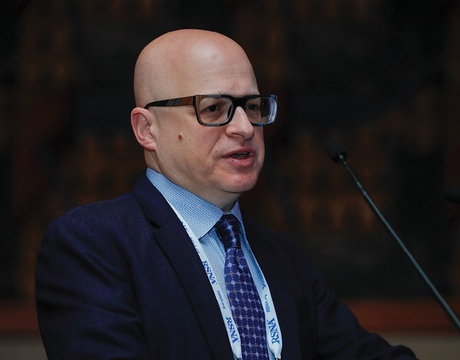As nuclear medicine departments strive to increase their impact in the multi-disciplinary care of patients, they might consider implementing a patient-centric nuclear medicine therapy care coordination service, according to a presentation delivered Tuesday.

Schuster
"I think these are very important concepts that put radiologists at the center of not only theranostic care, but by extension, even in the diagnostic realm," said David M. Schuster, MD, Division of Nuclear Medicine and Molecular Imaging, Emory University Hospital, Atlanta.
According to Dr. Schuster, the most common model currently in place within many nuclear medicine practices is what he calls the "limited encounter approach," in which nuclear medicine physicians simply carry out what an imaging order has instructed.
Another approach, less common in the U.S. and more common in Europe, Dr. Schuster said, is the independent model where nuclear medicine physicians are more independent and take over the entire aspect of care, including follow-up care and management of toxicities.
Developing a Patient-Centered Model of Care
According to Dr. Schuster, at Emory University Hospital the evolution toward a radiology-driven patient centered model began more than a decade ago when the hospital introduced high-dose sodium iodine therapy in combination with Thyrogen®, a laboratory produced thyroid stimulating hormone, in an outpatient setting.
"This change required a higher degree of coordination with the referring physicians," Dr. Schuster recalled. "And we became frustrated with being treated as technicians."
Patients would often arrive ill-informed and unprepared for thyroid cancer or hyperthyroid therapies. They might be accompanied by young children or partners, be totally ignorant of radiation safety precautions or even unaware that precautions were necessary, Dr. Schuster said.
"And explaining this at the last minute is not ideal."
Through a patient survey, the nuclear medicine department found that patients were being inadequately briefed by referring physicians and that patients wanted more time with nuclear medicine physicians to help them understand their nuclear medicine procedures in detail.
The original goals were modest," Dr. Schuster said. "We wanted to explain radiation safety precautions and patient preparation guidelines." But in a subtle shift, he explained, he and his colleagues became increasingly instrumental in patient care, such as for example, helping to determine whether patients should be treated in inpatient or outpatient settings.
"We were establishing closer relationships with our patients and taking time to explain more about the actual medicine to them than their endocrinologist could," he added. "This evolved over time and some endocrinologists pushed back. But others saw value in this, and we have now evolved to the point where they will send patients to us for a consult, even though they are not considering therapy right away just so we can give them our opinion."
Eventually, they developed checklists and protocols for consults and dedicated time for patient meetings to go through radiation precautions, answer questions and provide written radiation precaution materials.
"Over the years we realized we needed more help doing this," Dr. Schuster said. "Our health system was so enthusiastic about this that now we have a nurse navigator working with us and dedicated to nuclear medicine." That addition has helped the practice realize efficiencies and also frees physicians to see more patients and read their studies.
Finally, Dr. Schuster described the emergence of another spectrum of care model that puts nuclear medicine on "equal footing" as part of a multidisciplinary team. In this cooperative model, nuclear medicine physicians can see patients when needed, manage toxicities, be compensated for their time and have their own resources.
Related links:

